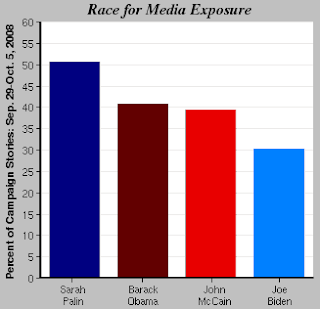The media has extreme power when it
comes to selectivity of who to cover, and who not to. Some of many of media’s
roles are to serve as a mentioner, expectation-setter, and agenda-setter. As a
mentioner, the media decides whose name gets out in the media. As an
expectation and agenda-setter, the media can cover particular angles of the
politicians in the spotlight and therefore control where the focus will be. The
media paid extensive attention to the 2008 vice presidential debates, much more
so than the debates between McCain and Obama who were running for president.
Pew Research reported that “Last week Palin led all the candidates in coverage,
registering as a significant or dominant newsmaker in 51% of campaign stories. /…/
Biden, who has largely been ignored by the media, was a significant or dominant
factor in 30% of the stories last week.” (Jurkowitz 2008)
Being the first Republican woman
ever to be nominated to be a vice presidential candidate; Sarah Palin was a
fascinating politician for media to scrutinize. Studies confirmed this
fascination through stating that more people paid attention to the vice
presidential debates than the presidential debates. “Discussion about McCain
selecting Palin accounted for 7 percent of all television election coverage of
the 2008 campaign, while the debate between Palin and Biden was the
most-watched vice presidential debate in U.S. history, attracting nearly 70
million viewers.” (Forster 2012) Therefore, this election is a good one to
research in order to find out what role gender played in media’s coverage of
the candidates Joe Biden and Sarah Palin.
Palin seemed to attract more
coverage in media than her opponent Biden did regardless of the type of media
outlet. “The average number of stories a day in overall coverage was 36 for
Palin, compared with 14.9 for Biden. On television, Palin was the subject of
8.8 stories a day compared with 4.6 for Biden; in newspapers, it was 15
compared with 8.2 stories a day, and on political blogs, 14.2 compared with 3.2
stories a day.” (Forster 2012) So first of all, media seemed much more
interested in Palin than Biden. Palin had the novelty of being the first
Republican woman on a major party ticket, which means that her gender put her
in the spotlight as soon as she received the nomination.
The evidence that Palin was covered
significantly more than Biden raises the questions of why and if the content of
the coverage incorporated gender stereotypes. A study by Bode and Hennings
confirm the gendered differences within the coverage of Palin and Biden. The
study anticipated that the gender stereotypes of men and women would emerge and
be visible through media coverage. Biden was hypothesized to receive more
coverage concerning male-dominated topics, such as the economy and foreign
policy. Palin was expected to receive much more coverage dealing with Sarah
Palins life outside of politics – her family relationships, her sense of
fashion (or lack thereof), and her
stance on more social rather than political issues. If there were any political
issue coverage of Palin, the issues were anticipated to correspond with what
women are thought to be better at. Those issues, called women’s issues, range
from education to health care. The authors of this study also found that “the
media did tend to talk about family (newspapers and television) and physical
appearance (newspapers and blogs) significantly more in coverage of Palin than
in coverage of Biden”, along with the finding that “Biden received
significantly greater coverage dealing with foreign policy (newspapers and
blogs) and the economy (television and blogs).” (Bode and Hennings 2012) We can
draw one conclusion from these findings – media already choose based on the gender
of the candidates what to focus their coverage on.
Another study was conducted by Forster after
the 2008 race that further confirms the findings in the first study. As stated
earlier, Palin’s immense coverage seemed to be focused on gender stereotypes
including stories addressing her fashion sense, her family, and her position on
social issues. However, one surprising finding that contradicts the assumption
that Palin would have received more coverage regarding women’s issues, such as
health care, suggests that Biden received significantly more coverage on these
issues than Palin did. This surprising finding is confirmed by Bode and Hennings
as well: “Biden actually received significantly more coverage [than Palin] in
each of those realms [education and health care] (in television and blogs).”
(Bode and Hennings 2012) Female politicians are often gendered into a corner of
politics where those topics belong to the thought to be “experts” – women–
however, the 2008 election showed some evidence of an anomaly in that case.
So what effects does this
difference in coverage produce? The authors of the study of the differences in
coverage and its content between Palin and Biden state: “Each of these
differences could have had important influences on public opinion formation and
the public's voting decisions in this particular race.” (Forster 2012) More
research has to be completed in order to fully answer the question of how
undecided voters tend to respond to media’s coverage of female and male
candidates, which is far from gender neutral. Does Sarah Palin’s skirt being
too short affect voters? These are the types of questions that will shed more
light on the power that the media possesses when labeling Sarah Palin’s
coverage as a ‘feminine’ one and Joe Biden’s as ‘masculine’.
-Johanna Killpack
Sources:
BODE, LETICIA and VALERIE M. HENNINGS. 2012. Mixed signals?
Gender and the media's coverage of the 2008 vice presidential candidates. Politics
& Policy 40, no. 2: 221-257.
Forster, Stacy. University of Winsconsin News. Accessed
11/8/2012. http://www.news.wisc.edu/20852
Jurkowitz, Mark. Pew Research Center Publications. Published
10/7/2008. Accessed 11/8/2012. http://pewresearch.org/pubs/986/campaign-economy-news-coverage


No comments:
Post a Comment